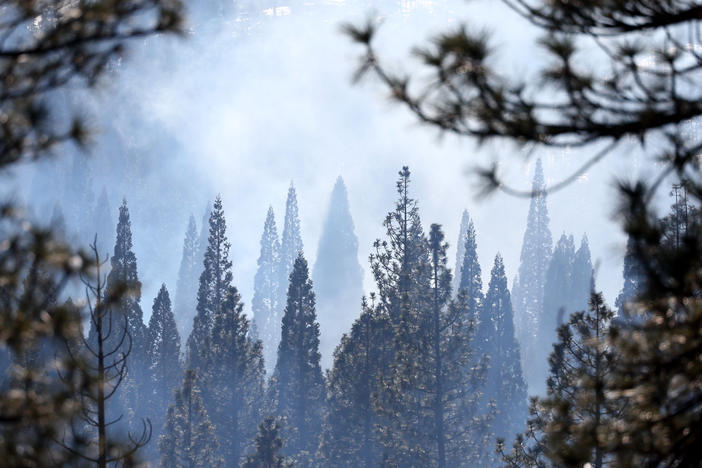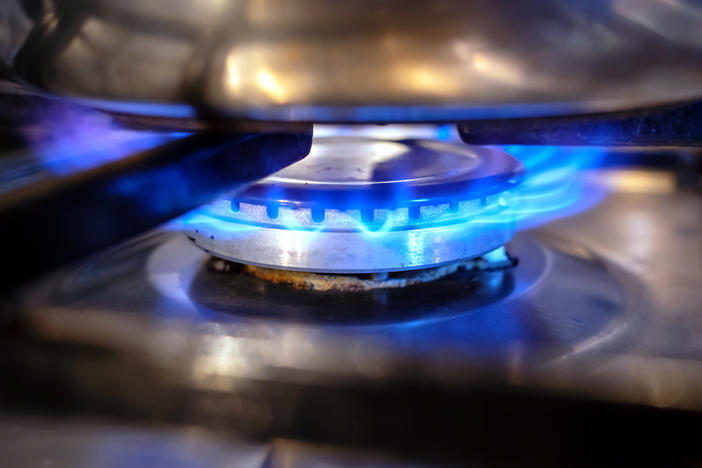Section Branding
Header Content
Sheltering Inside May Not Protect You From The Dangers Of Wildfire Smoke
Primary Content
Tens of millions of Americans are forced to live with wildfire smoke now every year. New research shows that it's more invasive than previously thought, infiltrating homes, schools and offices.
Transcript
MARY LOUISE KELLY, HOST:
For the millions of Americans dealing with wildfire smoke this summer, public health officials have a simple message. Close your doors. Shut your windows. Stay indoors. But as NPR's Nathan Rott reports, new research shows that may not be enough to keep you safe.
NATHAN ROTT, BYLINE: When you hear about hazardous air pollution, it's often based off of the measurement that's taken outside. That's where most air monitors are. But people, you and me - we spend roughly three-quarters of our time inside, says researcher Marshall Burke.
MARSHALL BURKE: And so what matters from an exposure perspective, then, is not what's happening outside but, really, what's happening inside.
ROTT: Burke lives in the Bay Area and is an Earth system scientist at Stanford University. But this really didn't hit home for him until last year, when the nation was under stay-at-home orders and huge swaths of the West, Bay Area included, were socked in suffocating wildfire smoke.
BURKE: And I have young kids, one who is asthmatic, and so I'm really, really worried and thinking about what those exposures look like.
ROTT: So he bought a low-cost PurpleAir monitor for inside his home.
BURKE: And our indoor pollution was sky-high during these wildfire events.
ROTT: Oftentimes the air inside was just as bad as it was out, no matter how many windows you shut. PurpleAir monitors allow users like Burke to post their data publicly online, almost like an exercise app.
BURKE: Yeah, it's like the Strava for air pollution, basically.
ROTT: So being a researcher, he went through all of the data and found that bad air was the case in households across the smoke-covered West. His research is scheduled to pre-publish soon. And while it hasn't yet been peer-reviewed, his findings are consistent with what others are seeing. Another study scheduled to publish later this year by the Environmental Protection Agency looked at air quality in western Montana during wildfire smoke events with a focus on the types of buildings that public health officials would usually recommend that at-risk people go to.
SARAH COEFIELD: We would say, you know, hey; if it's smoky outside, go to the library.
ROTT: This is Sarah Coefield, an air quality specialist in Missoula, Mont., who's helping with the study. And she says of the schools, daycares, businesses and other publicly accessible places they looked at...
COEFIELD: We did not have a single building with air that was, like, significantly better than outside. Some of the buildings, you might as well have been outside.
ROTT: Last year at least 1 in 7 Americans experienced dangerous air quality from wildfire smoke alone; this year, tens of millions more, including people hundreds of miles away from the fires. So this new research has major implications for public health officials like Sarah Coefield, who's now pushing...
COEFIELD: To have the public messaging during a smoke event change from, go inside, to, go inside and clean your air.
ROTT: Filter it. Remove the fine particulate matter that drifts through windows and doors and so deep into your bloodstream that it can trigger cardiac events.
MASON DOW: And some filters, so...
ROTT: That's why Mason Dow is at the food bank in Missoula, Mont., handing out box fans with air filters duct taped to them.
DOW: So this is a self-contained air filtration system, so tight seal on, like, doors and windows and stuff, middle of the room. And it filters the air pretty darn well.
ROTT: Fancy air filters can cost hundreds of dollars. And for a lot of people, like 67-year-old Janet Friede, who's been sick from the wildfire smoke this summer, that kind of money isn't just laying around. So she says outside, she's just been dealing with the smoke.
JANET FRIEDE: It makes me have a headache and stuff and tired, real tired.
UNIDENTIFIED PERSON #1: Filters on the back.
UNIDENTIFIED PERSON #2: Yeah.
ROTT: She's not alone. As people come through the food bank, grabbing these free DIY air filters, they mention sore throats, kids with asthma, headaches like Friede's. Forty fans are gone in 20 minutes.
AMY CILIMBURG: It feels a little bit maybe like a Band-Aid.
ROTT: Amy Cilimburg is the director of Climate Smart Missoula, the small nonprofit that's providing these air filters. Cilimburg says this work is a reflection of the reality. Climate change is here. It's happening.
CILIMBURG: The reason we're doing this is because we have longer, hotter, drier, smokier summers.
ROTT: So we need to adapt, she says, not down the road but right now.
Nathan Rott, NPR News, Missoula, Mont.
(SOUNDBITE OF KINOBE'S "CELESTION") Transcript provided by NPR, Copyright NPR.
Bottom Content



